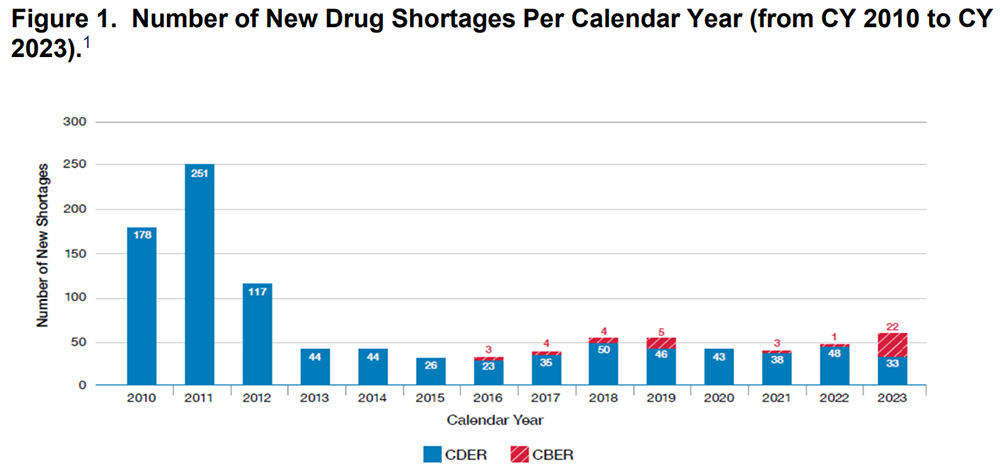Review FDA’s drug shortage report and discover the crucial role API suppliers play in meeting global demand.
Earlier this month, the FDA published its annual report to Congress detailing the level of drug shortages and efforts the agency is taking to mitigate them. In 2023, 55 new drug shortages were identified by the FDA. What products and areas were most prevalent, and what is the impact on drug manufacturers?
Tracking Drug Shortages
During the calendar year 2023, 55 new drug shortages were identified by the US Food and Drug Administration’s (FDA) Center for Drug Evaluation and Research (CDER) and Center for Biologics Evaluation and Research (CBER), according to a recent FDA report on drug shortages. Although the number of new drug shortages has declined since a peak high reached in 2011, when 251 new drug shortages were reported, drug shortages continue to be a problem. The 55 new shortages in 2023 were an increase over the 49 new drug shortages reported in 2022 and the 41 new drug shortages reported in 2021.
Although there has been a leveling off of new shortages over the past decade, 2023 has been a challenging year for shortages. One data point of note is the number of ongoing shortages yet to be resolved from previous years. As of December 31, 2023, the FDA had identified 98 ongoing CDER- and CBER-tracked shortages, which included 94 drug shortages identified by CDER and four by CBER.

Causes of Drug Shortages
Although the majority of drug shortages have historically been linked to quality and Good Manufacturing Practice (GMP) issues, in 2023, drug shortages also occurred as a result of increased demand. More than half of the shortages seen in 2023 were due, in part, to increases in demand, according to FDA’s report. Manufacturers are now not required to notify the FDA about shortages related to increases in demand, and the FDA is seeking new authority to require notification from manufacturers related to product demand-related drug shortages.
The FDA has put forth legislative proposals in its fiscal year 2025 proposed budget that would include authorities intended to promote the agency’s response efforts, such as requirements for manufacturers to notify the FDA of an increase in demand that the manufacturer likely will be unable to meet without meaningful shortfall or delay and to provide manufacturing volume and supplier information. If enacted, these proposals would greatly enhance the FDA’s ongoing work to address potential drug shortages.
Analysis by the U.S. Pharmacopeia (USP)
In a separate analysis, the U.S. Pharmacopeia (USP), an independent scientific organization, released its inaugural Drug Shortage Report earlier this month (June 2024), which encompasses trends up to the end of 2023 in the US. The report showed that shortages are lasting longer—the average drug shortage lasts for over three years compared to about two years in 2020—and impacts a wide range of therapeutic classes. More than half, 53%, of new drug shortages were generic sterile injectable medicines.
Through USP’s Medicine Supply Map, a tool that identifies, characterizes, and predicts risk in the supply chain, the report highlights four factors that singularly, or in combination, can leave a drug more vulnerable to shortage: low prices, manufacturing complexity, geographic concentration, and quality concerns.
Low Prices
Drug products, commonly older generics, with low prices have a higher risk of drug shortage. USP’s analysis shows that in 2023, product discontinuation increased by 40% in one year, from 100 drug products in 2022 to 140 in 2023, suggesting tightening margins forced manufacturers to tap out of the market. The report also showed that the average price of sterile injectable medicines in shortage was nearly 8.5 times lower than those not in shortage.
Manufacturing Complexity
Drugs with higher manufacturing complexity, such as sterile injectables, are more vulnerable to shortage. Manufacturing complexity can also be seen in certain therapeutic classes, such as certain antibiotics needing dedicated facilities, and in certain active ingredients that require complex chemical synthesis.
Geographic Concentration
Drugs in which the active pharmaceutical ingredient (API) and/or finished dose are made in a single or few locations are more susceptible to shortage.
Quality Concerns
Quality-related issues that surface in regulatory agency inspection outcomes and manufacturer recalls can also inform drug shortage risk but must be used along with other information to be meaningful.
Impact on Drug Manufacturers
In its report, the FDA says that based on its experience and its data on drug shortages, it believes that the requirements related to the early notification of permanent discontinuances and interruptions in manufacturing and the FDA’s own actions are helping to reduce the threat and impact of drug shortages. In 2023, the FDA said it worked with manufacturers to successfully avoid a large number of drug shortages, helping to prevent 236 shortages. For a comparison to recent years, the FDA helped prevent 317 shortages in 2021 and 222 in 2022.
FDA Initiatives and Actions
The FDA pointed to actions that it took in 2023 to address and prevent drug shortages, including incentivizing drug manufacturing establishments’ use of quality management maturity (QMM) practices. The FDA’s QMM program aims to encourage manufacturers of CDER-regulated drugs to implement quality management practices that go beyond current good manufacturing practice (cGMP) to support a more reliable drug supply chain.
Among the actions taken by the FDA in 2023 relating to QMM include the publishing of a white paper on QMM, CDER’s Quality Management Maturity (QMM) Program: Practice Areas and Prototype Assessment Protocol Development. The paper introduced five practice areas in the prototype assessment protocol: management commitment to quality, business continuity, advanced pharmaceutical quality systems, technical excellence, and employee engagement and empowerment. The paper provided examples of elements within each practice area that may be considered during an assessment.
The FDA also participated in a peer-reviewed journal article, published in January 2023, that shared lessons learned from two QMM pilot programs conducted with separate contractors to assess the QMM of drug manufacturers. One pilot program evaluated seven establishments located within the US that produce finished dosage form products marketed in the US. A second pilot program evaluated eight establishments located outside the US that produce APIs used in drug products marketed in the US.
Stakeholder Engagement
In addition, following the commitment made at the FDA’s Pharmaceutical Science and Clinical Pharmacology Advisory Committee in November 2022, CDER engaged with over 10 stakeholder groups in 2023 through facilitated discussions to solicit their input on the perceived benefits of the QMM program. The FDA’s CDER also established a public docket (September 15 to December 14, 2023) that garnered input from 23 individuals/entities. The feedback will assist CDER in further developing its QMM program.
Draft Guidance Documents
In April 2023, the FDA issued a draft guidance document, “Notifying FDA of a Discontinuance or Interruption in Manufacturing of Finished Products or Active Pharmaceutical Ingredients Under Section 506C of the FD&C Act,” to assist applicants and manufacturers in providing the FDA timely and informative notifications about changes in the production of certain finished drugs, biological products, and certain APIs that may, in turn, help the agency prevent and mitigate drug shortages. A revision of the draft guidance document was issued in February 2024.
Drug shortages remain a critical issue for the pharmaceutical industry, impacting manufacturers and patients alike. The FDA and other organizations continue to address the root causes of these shortages through various initiatives, legislative proposals, and stakeholder engagement. By improving quality management practices, enhancing communication, and promoting more robust supply chains, the industry can better manage and mitigate the risk of drug shortages in the future.
API Suppliers
API Suppliers
Comments are closed.











